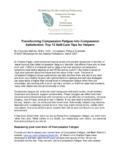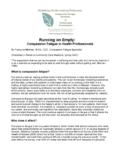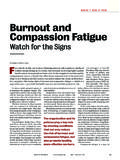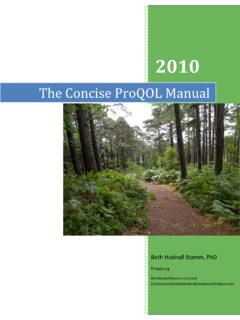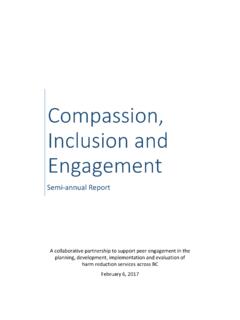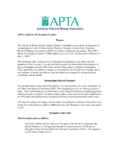Transcription of WHEN THE CARING GETS TOO TOUGH
1 Huggard, & Huggard, (2008). When the CARING Gets TOUGH : compassion fatigue and veterinary care. VetScript, May, 14-16. WHEN THE CARING GETS TOUGH compassion fatigue and Veterinary Care Peter Huggard Jayne Huggard One of the biggest favours any veterinarian can do for his or her patients, colleagues, and family, is to take self-care and stress control seriously . Dr Lisa Miller (JAVMA News, 2004) Veterinarians and veterinary nurses, along with other health care professionals, may experience compassion fatigue as a result of continued exposure to the traumatic events their patients and families experience. Also called secondary traumatic stress (STS) or vicarious traumatisation, the result can be a falling off in professional capabilities, emotional exhaustion, distress and burnout. This phenomenon is not only experienced by professional helpers and carers , but also by non-professional care-givers and volunteers.
2 compassion fatigue has been defined as the emotional burden that health care providers may experience as a result of overexposure to traumatic events that patients are experiencing (Schwam, 1998). An earlier term used to describe this phenomenon was secondary victimisation (Figley, 1982). Carla Joinson is generally credited with introducing the term compassion fatigue into the literature (Joinson, 1992) in an article about a special type of burnout being experienced by nurses in an emergency department. However, this term appeared 1 earlier in a journal titled New Zealand General Practice in February, 1990 (NZGP, 1990) describing the emotional burnout that may be experienced by clinicians. An associated process, with similar consequences to STS, is burnout. Burnout is a multidimensional construct that includes elements of emotional exhaustion, depersonalisation, and reduced personal accomplishment (Maslach & Jackson, 1981).
3 Emotional exhaustion is a key finding in studies of burnout in doctors; in a study of rural physicians in British Columbia, for example, 80% of participants reported moderate-to-severe levels of emotional exhaustion (Thommansen, Lavachy, Connelly, Berkowitz & Grzybowski, 2001). Other similar studies have highlighted high levels of emotional exhaustion and distress in this population. Current thinking is that compassion fatigue is an occupational stress that anyone in CARING and helping professions can experience, and over the last decade there has been an increasing awareness of the need to develop ways to care for our carers . With this, is a growing recognition of the necessity for a three-pronged approach to managing occupational stress. Firstly, an organisational responsibility to care for staff, secondly, an obligation amongst peers to support colleagues, and thirdly, a personal responsibility to care for oneself.
4 A coping strategy sometimes adopted by health professionals is to avoid experiencing compassion fatigue by remaining emotionally detached from their patients. However research has shown that remaining detached can still lead to stress and emotional exhaustion, and that behaving in an empathic way with patients gives better levels of care (Arnetz, 1997; Wilters, 1998). What then is the connection between the process of compassion fatigue and those professionals working in the veterinary field? There have been a small but increasing 2 number of commentary articles appearing in veterinary publications that have discussed burnout and compassion fatigue (Mitchener & Ogilvie, 2002; Cohen, 2007). A book, examining the process of compassion fatigue , has also recently appeared (Figley & Roop, 2006). In the August 15, 2004 issue of JAVMA News, Dr. Lisa Miller, former chair of the AVMA Committee on Wellness, describes compassion fatigue as a consequence occurring when an individual is depleted of internal emotional resources , and that people in caregiving professions, especially those who work in emergency situations, can be vulnerable (JAVMA News, 2004).
5 She also says that, because compassion fatigue is not an exact science it is difficult to discuss, particularly during training. However, recent studies with New Zealand doctors have identified protective processes and have shown that there is a strong connection between an individual s level of resilience and emotional competence and their level of compassion fatigue . High resilience and emotional competence has been shown to be related to low levels of compassion fatigue (Huggard, 2006). Dr Miller (JAVMA News, 2004) lists the following strategies aimed at managing the stresses associated with veterinary practice: taking care of yourself; having fun on a regular basis; turning to nature; finding a relaxation technique that works for you; changing your attitude to how you view the stressors; knowing when to ask for help everyone experiences occasional frustration or weariness.
6 She describes other practical approaches such as: organizing staff meetings to discuss concerns and feelings; reassessing the boundaries that have been developed with clients; giving yourself permission to grieve when you lose a patient; surrounding yourself with supportive people; and, if you decide to seek help, identifying a counsellor or psychologist who understands compassion fatigue and is familiar with the veterinary profession. 3 One of the most effective ways of managing the stresses associated with clinical practice is by participating in a supportive peer supervision group process. The New Zealand College of General Practitioners (RNZCGP, 2000) recommends that general practitioners regularly and actively participate in a peer group. Peer groups differ in the way they occur some have more of a social nature (often serving a useful purpose); some have participants presenting complex and difficult cases; and some, such as Balint groups, examine stressful, and often emotionally demanding, situations in a safe and confidential environment.
7 A Balint group is traditionally led by a psychiatrist or psychotherapist, and meets regularly to discuss those patients who appear to be invoking some form of distressing response within the general practitioner (Benson & Magraith, 2005). Additional supportive strategies include: developing strong personal support networks having one s own GP (ie not engaging in practices of self-investigation, diagnosis, or treatment) finding a mentor agreeing to, and actively engaging in, professional supervision taking part in Balint groups. At an individual level, one of the most useful ways of mitigating the effects of compassion fatigue is to personally find ways to leave the professional role at work at the end of each day. The work that you do is often complex, difficult, stressful and sad. It is important to remember however, that the sadness belongs to your patients and their families, it is not yours to take away.
8 Finding ways to acknowledge the sadness, and then leave it behind, is crucial to health professional s wellness. 4 The following Personal Debriefing Model focuses on finding ways that actively attend to disengaging from work, takes only a few minutes and can be done on your own. The personal reflection required is therapeutic in itself. Check that tasks are finished, and documentation completed. Deal with outstanding issues: o Complete if essential, OR o Delegate, OR o Write it down to do tomorrow Formally acknowledge when the work day is completed, and, if part of an on-call roster, remember who is on call and remind yourself that you have handed over clinical responsibility to that person. Remember what went well in the day, and what didn't, and, rather than dwell on the negatives, focus on the positive outcomes of the day. Acknowledge you did your best with the resources available to you.
9 Say your goodbyes, giving closure for now to both collegial and client relationships. Take off your name badge or develop other personal rituals that signify that work is now completed. Make your journey home a separation between work and private life, even if you live on the premises. Try hard to not take work home, but if you must, create a specific space for your professional work and only use it for this purpose. These strategies are about boundary-setting and de-roling as we move from our professional life to our private self (Huggard, 2007). 5 Finally, it is important to know that whatever work you do, and wherever you do it, you never need to feel alone have the names of trusted colleagues you can call and talk through a situation should the need arise, or use email if your support is out of town. References Arnetz, (1997). Physicians view of their work environment and organization.
10 Psychotherapy and Psychosomaics, 66, 155-62. Benson, J. & Magraith, K. (2005). compassion fatigue and burnout: the role of Balint groups. Australian Family Physician, 34 (6), 497-8. Cohen, (2007). compassion fatigue and the Veterinary Health Team. Veterinary Clinics of North America: Small Animal Practice, 37 (1), 123-134. Deckard, G., Meterko, M., & Field, D. (1994). Physician burnout: an examination of personal, professional, and organisational relationships. Medical Care, 32, 745-54. Figley, (1982, February). Traumatization and comfort: Close relationships may be hazardous to your health. Keynote presentation, Families and close relationships: Individuals in social interaction. Conference health at Texas Tech University, Lubbock. Figley, & Roop, (2006). compassion fatigue in the Animal-Care Community. Washington: Humane Society Press. Huggard, (November 2006).

